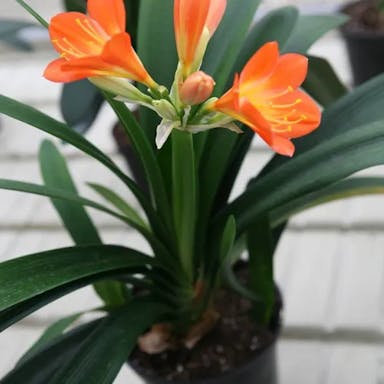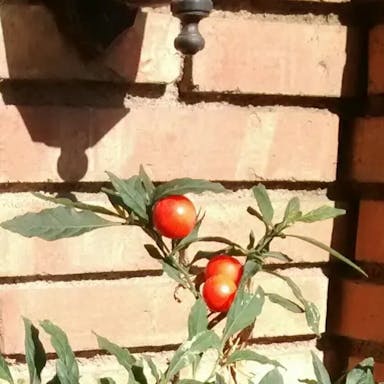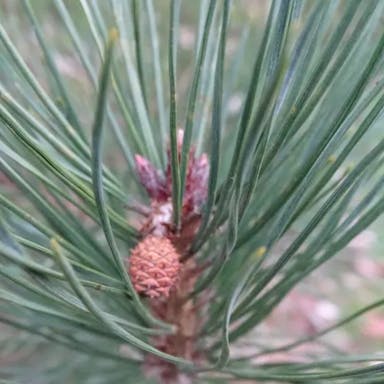Desert lavender, scientifically known as Condea emoryi, is a plant species that belongs to the Lamiaceae family. It is native to the Sonoran Desert in the southwestern United States and northwestern Mexico. This perennial shrub can reach a height of up to 3 feet and has a spreading growth habit. The leaves are gray-green in color, narrow, and covered in fine hairs, which help the plant conserve water in its arid habitat. The flowers of Condea emoryi are small and tubular, arranged in dense spikes at the tips of the branches. They are typically a vibrant purple or lavender color, giving the plant its common name. The flowers attract pollinators such as bees and butterflies, contributing to the plant's reproductive success. Condea emoryi is a drought-tolerant plant that thrives in well-drained sandy or rocky soils. It is adapted to the harsh conditions of the desert, including high temperatures and low rainfall. This plant is relatively easy to grow in arid and semi-arid regions, making it a popular choice for xeriscaping and native plant gardens. The fruit of the desert lavender are small, dry capsules that contain tiny seeds. These capsules split open when mature, dispersing the seeds to ensure the plant's propagation. In summary, Condea emoryi, or Desert lavender, is a resilient and visually appealing plant that adds beauty and biodiversity to arid landscapes.
Desert lavender
- Scientific name
- Condea emoryi
Basic Information
- Lamiaceae Family Condea Genus Desert lavender Species
- Lamiaceae > Condea > Condea emoryi
- 83%
- The Completeness of This Encyclopedia
Please help us complete the encyclopedia, Terrarium is a encyclopedia service to be completed with everyone in the world. Currently, this page is 83% complete. For more information on how to contribute, please click here.
- Height
- Flower Color
- Leaf Color
- Anthesis
- Sunlight Exposure
Full Sun Long hours of sunlight from morning to afternoon Partial Shade A location in the shade of a tree or where either the morning or afternoon is shaded Full Shade A place where there is no direct sunlight
- Hardiness Zones
This is an indicator to know to which zone each plant can winter. Knowing the zone of each plant gives you an idea of the cold temperature resistance when grown in the ground without a roof. 2: -42.7 to -40.0 3: -39.9 to -34.4 4: -34.3 to -28.9 5: -28.8 to -23.3 6: -23.2 to -17.8 7: -17.7 to -12.2 8: -12.1 to -6.7 9: -6.6 to -1.1 10: -1.0 to 4.4 11: 4.5 to 10.0
- Cold resistance
- Heat resistance
- Habitat of origin
- Growth Rate
What is Desert lavender (Condea emoryi)?
What is Desert lavender (Condea emoryi)
Flower meaning
The desert lavender language of flowers for that plant in America is: - Desert lavender means calm, peace, and quiet. - It shows harmony in bonds between people. - Desert lavender also relates to curing and relaxing. - It can share purity and innocence. - This flower is frequently used for thanks and praise. One example of flower language is using desert lavender for calm. The soft purple desert lavender flowers often connect to peace and quiet. Giving someone desert lavender expresses wanting them to find inner peace. It's a nice way to share a message of emotional well-being. Remember flower language can differ due to culture and history.
Calendar of Desert lavender (Condea emoryi)
Calendar
Desert lavender, scientifically known as Hyptis emoryi, is a plant species native to the United States. It typically blooms during the spring and summer months, specifically from April to September. The period of time required for Desert lavender to bloom can range from a few weeks to several months. To ensure longer blooming, it is important to deadhead the faded flowers. In the peak of summer, the chances of rainfall are slim. Arid conditions cause plants to expend more energy accessing groundwater. As a result, blooming periods become shorter. To promote continuous blooming, gardeners should provide supplemental irrigation. Additionally, applying organic mulch helps retain soil moisture. It is advisable to consult local resources to obtain accurate details on ideal growing conditions. Factors like sunlight, drainage and climate impact the duration of blooms. With proper care, gardeners can prolong the flowering of Desert lavender from early spring through late summer.
How to grow Desert lavender (Condea emoryi)
Watering
Desert lavender, Hyptis emoryi, requires a watering regimen to thrive. It is important to water the plant deep and allow the soil to dry out before watering again. Watering frequency will depend on temperature, humidity, and soil type, but approximately every 7-10 days. Avoid overwatering, as excessive water causes problems. In winter, watering should be reduced significantly to mimic natural rainfall patterns. Monitor soil moisture levels and adjust watering appropriately.
Soil and Fertilizer
Desert lavender, scientifically known as Hyptis emoryi, thrives in arid desert regions with well-drained soil. It assists sandy or gravelly soil with a pH range of 6.0 to 8.0. The plant necessitates full sun exposure for ideal maturation and flowering. When contemplating fertilizers, a balanced slow-release fertilizer with an NPK ratio of 10-10-10 or 14-14-14 is advocated. The fertilizer should be applied in preceding spring, just earlier than the maturing season inaugurates. Apply the fertilizer at a pace of 1 tablespoon per square foot of soil. During the maturing season, which characteristically endures from spring to fall, it is advisable to apply a liquid fertilizer every 4-6 weeks. Dilute the liquid fertilizer according to the manufacturer's instructions and apply it straightforwardly to the soil around the base of the plant. It is consequential to note that immoderate fertilization can lead to inordinate vegetative maturation and decreased flowering. Consequently, it is essential to pursue the recommended dosage and frequency of fertilizer application.
Sunlight and Place
Desert lavender, scientifically known as Hyptis emoryi, is a plant that thrives in full sun exposure. It has high tolerance of both cold and heat. The temperature range it grows best in is 70°F and 90°F (21°C and 32°C). When it's summer, giving enough water prevents drying out. In winter it needs less water because growth is slower. For where to put it, Desert lavender should go where drainage is good and gets lots of sun. It can take strong sunlight and needs at least 6 hours of direct sun every day to thrive. Too much shade is bad for its growth and flowering. Overall, Desert lavender is very hardy and can handle different temperature extremes. It needs a lot of sunlight to grow best.
Advanced Information of Desert lavender (Condea emoryi)
Pruning
Desert lavender, scientifically known as Hyptis emoryi, is a plant that benefits from regular pruning and cutting back. Careful cutting helps shape the plant, encourages lively progress, and prevents excessive growth. Tooling also helps remove faded or injured branches, refining the plant's features. The finest minute to prune is when spring starts but before sprouts arrive. Pruning then lets the plant bounce back rapidly and energizes thriving in the sprouting season. When pruning, clean, sharp cutters should be utilized to produce neat reductions and minimize sickness. To prune, firstly eliminate any withered or infected twigs by slicing them to robust tissue. Next, selectively cut any branches crossing or abrading each other to develop air flow and lessen illness. Finally, form the plant by slicing overly lengthy or messy branches to retain a packed and neat look. After pruning, dispose of pruned remnants to stop the spread of pests or diseases. Also, appropriate care like standard watering and nourishment will assist recuperation and thriving after pruning. Please note that guidance given is founded on general shrub pruning and may differ based on specific conditions and recommendations. It is wise to check local resources or experts for particular Desert lavender pruning guidance.
Planting and Harvest
Desert lavender, scientifically known as Hyptis emoryi, is a plant that can be potted or planted in the ground. When potting Desert lavender, choose well-draining potting mix and container with drainage holes. Gently remove plant from nursery container, place in pot with potting mix and water thoroughly after potting. In the ground, choose sunny location with well-draining soil. Plant at same level as nursery container and water thoroughly after planting. Repot every 2-3 years when outgrown current pot using same potting procedure but larger pot. Mishowing can lead to poor growth. Provide adequate sunlight, well-draining soil and regular watering. Avoid overwatering causing root rot. Pruning maintains shape and removes damaged branches. In summary, pot or plant Desert lavender in ground. Choose drainage when potting and sunny location when planting. Repot when necessary. Proper care like sunlight, drainage and watering is essential. Prune as needed.
Propagation
Desert lavender do be propagated via various methods like sowing seeds, division, cuttings, and leaf cuttings. For sow seeds, gather mature seeds from the shrub and put in well-draining dirt. Keep moist and give indirect light. Sprouting takes around 2-4 weeks. For division, vigilantly unearth the bush and break up the clumps into tinier bits, ensuring all bit has roots. Replant the pieces in prepared soil, soak thoroughly, and give adequate sunlight. For cuttings, take 4-6 in stem cuttings from the bush, ensuring a couple nodes. Remove lower leaves and soak the cut end in rooting liquid. Plant the cuttings in draining potting mix, keep damp, and provide indirect light. Rooting is around 4-6 weeks. Leaf cuttings also work. Take healthy leaves and cut into bits, ensuring each has a vein. Plant the leaf bits in draining soil, keep damp, and provide indirect light. New plants develop from the leaf bits in a couple weeks. Harvesting can be done when the plant is blooming fully. Cut the flower stalks over a leaf node to motivate new growth.
Pests and Diseases
Desert lavender (Hyptis emoryi) is susceptible to several insect pests and fungal infections. One common insect that feeds on the plant sap is the aphid, which can stunt growth and deform leaves. Another sap-feeding pest is the whitefly, which can spread viral sicknesses. Spider mites are another potential pest, making leaves yellow and stippled. For illnesses, Desert lavender can get powdery mildew. This white powdery fungal disease appears on leaves. It can make leaves curl and fall early. Root decay is another problem, caused by overwatering or poor drainage. This can result in wilting and death. To prevent these, it is vital to regularly check the plant for pests and diseases. Removing affected leaves or plants can prevent spreading. Also, proper care like avoiding overwatering and ensuring drainage prevents root decay. In summary, Desert lavender can get pests like aphids, whiteflies, and spider mites. It also gets diseases such as powdery mildew and root rot. Regular inspection, removing affected parts, and proper care can prevent issues and ensure plant health.
Habitat of Desert lavender (Condea emoryi)
Habitat
Toxicity of Desert lavender (Condea emoryi)
Health Benefits
- edible
- Unknown
- Toxic
- Unknown
NO DATA
Toxic for dogs and cats
NO DATA
Q&A of Desert lavender (Condea emoryi)
- Where can you find Desert Lavender plants for sale?
Desert Lavender plants, scientifically known as Condea emoryi, can be found for sale at various online nurseries and botanical garden stores that specialize in desert and drought-tolerant plants. Many websites offer this hardy plant, including High Country Gardens and Etsy. Regional nurseries may sell it too. The southwest United States has arid areas suited to Desert Lavender. Carefully follow instructions for the plant. It prefers full sun exposure and well-drained soil. Prune lightly in spring. Water when the soil dries out. Protect from excess winter moisture.
0
0
- Is there a recommended way to choose Desert lavender?
Desert lavender, scientifically known as Hyptis emoryi, is a plant native to the Sonoran Desert. It is important to consider their growth habit and size when selecting them. The 'Desert Lavender' variety is a compact shrub that reaches a height of 2-3 feet and produces purple flowers in the summer. Another variety, 'Yellow Desert Lavender', has yellow flowers and a similar growth habit. When buying seeds of it, fresh seeds that are not discolored or damaged should be chosen. Soaking the seeds in water for 24 hours before planting to improve germination is recommended. Sow the seeds in soil draining well and keep them moist until they germinate. If buying seedlings, healthy plants with green leaves and no signs of disease or pests should be chosen. Transplanting the seedlings into soil draining well and providing regular watering until they establish is necessary. It prefers full sunlight and can tolerate drought conditions once established. Remember to provide adequate space for the selected variety to grow and thrive. With proper care, it can be a beautiful addition to your garden or landscape.
0
0
- What are the various uses of Desert Lavender?
Desert Lavender, scientifically known as Condea emoryi, has great traditional use in natural medicine. The dried leaves steeped to make a tea thought to help support healthy breathing and digestion. This drought-tolerant plant survives well outdoors in dry places. Beautiful purple blooms adorn the shrub, giving it decorative purpose. Extracts from the aromatic leaves also find use in perfumery.
0
0








